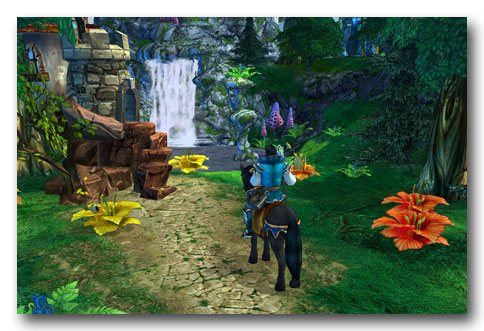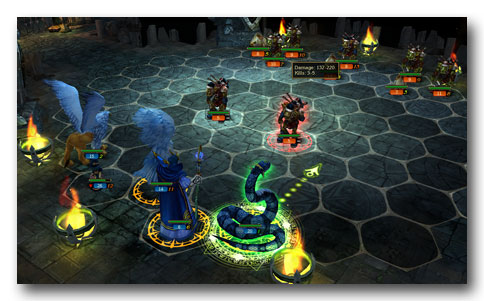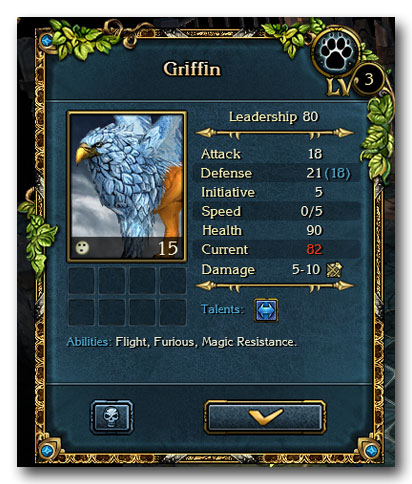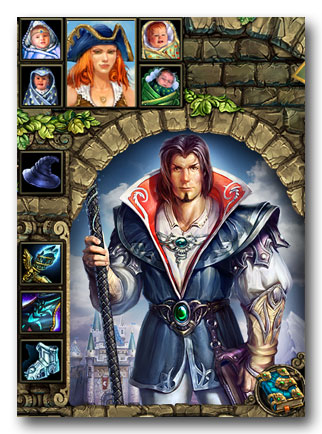
King’s Bounty: The Legend comes from a Russian developer, takes its name and inspiration from an old strategy game from the US, and features the meticulous attention to artistic detail typically seen in games from Japan. It comes as no surprise Vladivostok-based Katauri Interactive thanked New World Computing, Blizzard and Square Enix in the game’s credits because KB:TL appropriates ideas from all those companies. KB:TL has the original game‘s accessibility and gameplay hooks, the cartoony look and derivative lore of the Warcraft series, and the graphical flourishes one might find in Final Fantasy.
KB:TL was originally known as Battle Lord, the sort of generic title Russian developers delight in foisting on their games. (Other results of the Russian-to-forgettable-English translation process include Fantasy Wars and Space Rangers.) It was a title so generic the game’s publisher, 1c, was moved to procure the rights to an old New World Computing strategy game presumably for greater brand recognition in the US market. The name is a very good fit even though Jon Van Caneghem had nothing to do with the design.
Like the original King’s Bounty (and the successful Heroes of Might and Magic franchise that later refined the formula), KB:TL is a strategy game in the beer and pretzels style popularised in the 90s. Games like the classic Panzer General and more eclectic fare like Charles Moylan‘s turn-based air combat sims were very easy to get into yet possessed hidden complexity which made them deeply satisfying to master. Learning how to play Panzer General, for example, was trivially easy; formulating strategies and tactics that could see German forces mount an ahistorical assault on Washington was not. KB:TL may be lighter on the strategy than, say, Panzer General but it is still capable of providing a satisfying challenge.

KB:TL plays like an eccentric merging of Diablo and HoMM. The real-time exploration is reminiscent of Blizzard’s best-seller while combat is resolved with a battle system best realised in New World Computing’s popular strategy franchise.
The player character travels the beautiful game world seeking battles, wrongs to right and treasure. Various points of interest provide quests, reinforcements and bonuses. It’s a very large game world and the player would be well advised to annotate the in-game map as it’s all too easy to completely forget the location of troop sources or quest-givers. This part of the game rewards the diligent explorer as there are items to be found in nooks and crannies (some of which are critical to player character development) that are revealed only if the screen is rotated in just the right way.
Exploration is made complicated by enemy mobs found throughout the land. These mobs are initially static (though they will give chase over short distances once provoked) but towards the end of the campaign, there are dangerous armies that roam the land. There are killer stacks even in the starter area of Greenwort which must be avoided in the beginning. While these can be tackled eventually, some patience and discretion will be necessary. In this respect, the game feels refreshingly old — a throwback to a time when game designers were not afraid to frustrate the thoughtless, careless gamer.

Upon engaging foes, the screen switches to a turn-based battle system that will be immediately familiar to HoMM veterans. Battles take place on beautiful 3D hex maps that can be zoomed in and out, and rotated this way and that. Units are well represented, and watching them in action is pleasant enough. Katauri Interactive has gone with the Square Enix approach here, gussying up the proceedings with flashy spell effects and superfluous animations for summons. Thankfully, the Russians are at least capable of showing some restraint before everything sinks in a morass of tackiness.
In battle, the game is primarily about managing attrition. While winning battles is not especially hard, the player will be compelled to minimise casualties, which can be challenging. Building an army requires gold, which can be found conveniently scattered on the ground but is mostly gained through victories. Initially, units seem disposable. The loss of an entire troop of bowmen may not sting at the start of the game as there will be a horde of replacements available nearby but it would be unwise to needlessly throw away troops in battle deeper into the lengthy campaign.

There are a huge number of units, most with special abilities, resistances and vulnerabilities that will only be fully appreciated in battle. The player will discover the hard way not all units are equal and some troops are much more useful in battle than others.
Rebuilding the army after a costly battle is the most annoying part of the game as it may entail considerable backtracking to bring units back up to fighting strength. To complicate matters, supply sources can run out of troops and are only replenished as the game progresses past certain campaign checkpoints. Thus, the player must focus on achieving victory with minimal losses.
The game has a quirkiness and sense of playfulness which not only enlivens the otherwise conventional storyline but extends to the game mechanics. For instance, the player character can get married, have children, get a cheap divorce and remarry. This is primarily noteworthy because of how little time all this takes. Siring four children within 77 days somehow seems a greater achievement than saving the world. The big lesson to take home from this game is family is important because the king rewards you with gold for having children and the babies themselves provide combat bonuses. Precisely how a swaddled baby placed in his mama’s equipment slot manages to improve an army’s offense out in the battlefield is a question best left to military strategists to ponder.

Special mention must be made of the music. There be dragons that need be slain, demons to be driven back, kingdoms to be saved, and Lind Erebros’s magical compositions make a perfect accompaniment. Under the Shadow of the Oak and To the Horizon are the standouts. The former is a melancholic tune that’s goose-bumpingly good (although much too short) while the latter is a stirring call to adventure. Katauri Interactive must also be commended for making the tunes easily accessible outside the game, something more developers ought to do.
Overall, KB:TL can be recommended with little reservation for the fan looking for a modern version of HoMM’s solid battle system. This is undeniably a stylish, confident and polished game.
Yet it must be pointed out we’ve seen this game before. We’ve seen the gameplay. We’ve seen the look. We’ve read variants of this lore. This isn’t a critical failing, of course — Blizzard has a long and successful history appropriating ideas from others — but it is a little disappointing the Russian developer didn’t imbue its beautifully crafted game with more novelty and originality. With KB:TL, Katauri Interactive has proven it can emulate American and Japanese developers, both past and present. It must now strive to find its own identity. To recall history may provide some satisfaction, but true legends are never content to relive the past.
